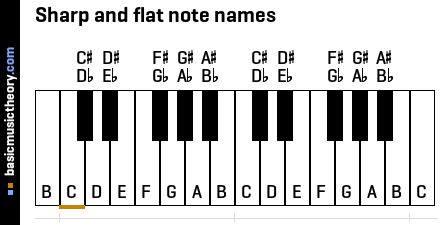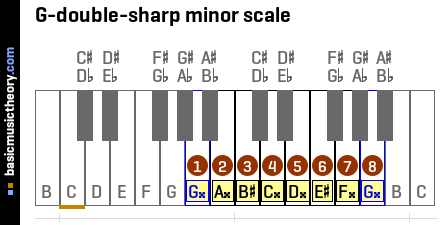G-double-sharp minor key signature
The Solution below shows the G## natural minor key signature on the treble clef and bass clef.
The Lesson steps then explain how to write the key signature using both clefs, including the display order and line / space staff positions of the notes, and the sharp / flat accidentals.
For a quick summary of this topic, have a look at Key signature.
| Key | C | C# | Db | D | D# | Eb | E | E# | Fb | F | F# | Gb | G | G# | Ab | A | A# | Bb | B | B# | Cb | All On 1 page |
|---|
Solution
1. G-double-sharp minor key signature
The G-double-sharp minor scale has 2 sharps, 5 double-sharps.
Warning: The G-double-sharp key is a theoretical minor scale key.
This means:
> Its key signature would contain either double-sharps or double flats.
> It is rarely used in practice, because it is too complex to use.
> It is not on the Circle of fifths diagram, which contains the most commonly used keys.
> There is always an identical minor scale that you can use in its place, which is on the Circle of 5ths.
> The A natural minor scale sounds the same / contains the same note pitches, which are played in the same order (the scales are enharmonic), so it can be used as a direct replacement for the G-double-sharp minor scale.
| No. | 1 | 2 | 3 | 4 | 5 | 6 | 7 | 8 |
|---|---|---|---|---|---|---|---|---|
| Note | G## | A## | B# | C## | D## | E# | F## | G## |
These note names are shown below on the treble clef followed by the bass clef.


| Bass Clef: | Midi | MP3 | Treble Clef: | Midi | MP3 |
Lesson steps
1. Piano key note names
The white keys are named using the alphabetic letters A, B, C, D, E, F, and G, which is a pattern that repeats up the piano keyboard.
Every white or black key could have a flat(b) or sharp(#) accidental name, depending on how that note is used. In a later step, if sharp or flat notes are used, the exact accidental names will be chosen.

The audio files below play every note shown on the piano above, so middle C (marked with an orange line at the bottom) is the 2nd note heard.
| Bass Clef: | Midi | MP3 | Treble Clef: | Midi | MP3 |
2. G-double-sharp minor notes
The G## natural minor scale has 2 sharps, 5 double-sharps.
| No. | 1 | 2 | 3 | 4 | 5 | 6 | 7 | 8 |
|---|---|---|---|---|---|---|---|---|
| Note | G## | A## | B# | C## | D## | E# | F## | G## |

To understand why the G-double-sharp minor scale has 2 sharps, 5 double-sharps, have a look at the G## natural minor scale page, which shows how to identify the note positions and names for this scale.
Since this is a none-based key signature, the music theory rules for constructing key signatures containing nones are covered in the next step.
| Bass Clef: | Midi | MP3 | Treble Clef: | Midi | MP3 |
| Key | C | C# | Db | D | D# | Eb | E | E# | Fb | F | F# | Gb | G | G# | Ab | A | A# | Bb | B | B# | Cb | All On 1 page |
|---|
| Related links | G-double-sharp natural minor key signature, G##, G## natural minor scale |
|---|---|
| More minor scales | G## harmonic minor scale, G## melodic minor scale |
| Other scales | G## major scale |
| Intervals | G##-1st, G##-2nd, G##-3rd, G##-4th, G##-5th, G##-6th, G##-7th, G##-8th |
| Circle of 5ths | Learn the circle of fifths |
| Triad chords | G## diminished, G## minor, G## major, G## augmented, G## suspended 2nd, G## suspended 4th |
| 6th chords | G## minor 6th, G## major 6th |
| 7th chords | G## dim 7, G## half-dim7, G## min 7, G## min-maj 7, G## dom 7, G## maj 7, G## aug 7, G## aug-maj 7, G## maj 7 sus2, G## dom 7 sus4, G## maj 7 sus4 |
| Cadences | G## major perfect authentic, G## major imperfect authentic, G## major plagal, G## major half, G## major deceptive |